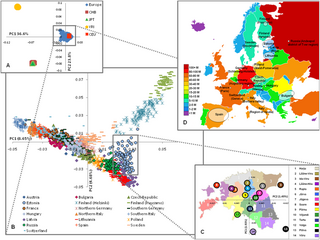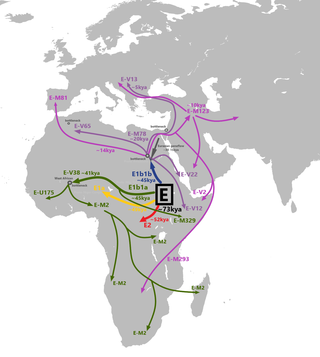Y-chromosomal Aaron is the name given to the hypothesized most recent common ancestor of the patrilineal Jewish priestly caste known as Kohanim. According to the traditional understanding of the Hebrew Bible, this ancestor was Aaron, the brother of Moses.

A haplotype is a group of alleles in an organism that are inherited together from a single parent.

A haplotype is a group of alleles in an organism that are inherited together from a single parent, and a haplogroup is a group of similar haplotypes that share a common ancestor with a single-nucleotide polymorphism mutation. More specifically, a haplogroup is a combination of alleles at different chromosomal regions that are closely linked and that tend to be inherited together. As a haplogroup consists of similar haplotypes, it is usually possible to predict a haplogroup from haplotypes. Haplogroups pertain to a single line of descent. As such, membership of a haplogroup, by any individual, relies on a relatively small proportion of the genetic material possessed by that individual.
Haplogroup J is a human mitochondrial DNA (mtDNA) haplogroup. The clade derives from the haplogroup JT, which also gave rise to haplogroup T. In his book The Seven Daughters of Eve, Bryan Sykes named the originator of this mtDNA haplogroup Jasmine. Within the field of medical genetics, certain polymorphisms specific to haplogroup J have been associated with Leber's hereditary optic neuropathy.
Haplogroup HV is a human mitochondrial DNA (mtDNA) haplogroup.

Ethiopians are the native inhabitants of Ethiopia, as well as the global diaspora of Ethiopia. Ethiopians constitute several component ethnic groups, many of which are closely related to ethnic groups in neighboring Eritrea and other parts of the Horn of Africa.

The genetic history of Europe deals with the formation, ethnogenesis, and other DNA-specific information about populations indigenous, or living in Europe.

In human mitochondrial genetics, Haplogroup Y is a human mitochondrial DNA (mtDNA) haplogroup.

The genetic history of the Middle East is the subject of research within the fields of human population genomics, archaeogenetics and Middle Eastern studies. Researchers use Y-DNA, mtDNA, and other autosomal DNAs to identify the genetic history of ancient and modern populations of Egypt, Persia, Mesopotamia, Anatolia, Arabia, the Levant, and other areas.
Haplogroup R0 is a human mitochondrial DNA (mtDNA) haplogroup.

African admixture in Europe refers to the presence of human genotypes attributable to periods of human population dispersals out of Africa in the genetic history of Europe. for example, certain Y-DNA and mtDNA lineages are thought to have spread from Northeastern Africa to the Near East during the later Pleistocene, and from there to Europe with the Neolithic Revolution.
Genetic studies on Jews are part of the population genetics discipline and are used to analyze the chronology of Jewish migration accompanied by research in other fields, such as history, linguistics, archaeology, and paleontology. These studies investigate the origins of various Jewish ethnic divisions. In particular, they examine whether there is a common genetic heritage among them. The medical genetics of Jews are studied for population-specific diseases.
The genetic history of North Africa has been heavily influenced by geography. The Sahara desert to the south and the Mediterranean Sea to the North were important barriers to gene flow from sub-Saharan Africa and Europe in prehistoric times. However, North Africa is connected to Western Asia via the Isthmus of Suez and the Sinai peninsula, while at the Straits of Gibraltar North Africa and Europe are separated by only 15 km (9 mi), similarly Malta, Sicily and Crete are close to the coasts of North Africa.

The genetic history of Egypt reflects its geographical location at the crossroads of several major biocultural areas: North Africa, the Sahara, the Middle East, the Mediterranean and sub-Saharan Africa.
The relationship of the Mayas to other indigenous peoples of the Americas has been assessed using traditional genetic markers. Mayas inhabited several parts of Mexico and Central America, including Chiapas, the northern lowlands of the Yucatán Peninsula, the southern lowlands and highlands of Guatemala, Belize, and parts of western El Salvador and Honduras. Genetic studies of the Maya people are reported to show higher levels of variation when compared to other groups.
The Bulgarians are part of the Slavic ethnolinguistic group as a result of migrations of Slavic tribes to the region since the 6th century AD and the subsequent linguistic assimilation of other populations.
Population genetics is a scientific discipline which contributes to the examination of the human evolutionary and historical migrations. Particularly useful information is provided by the research of two uniparental markers within our genome, the Y-chromosome (Y-DNA) and mitochondrial DNA (mtDNA), as well as autosomal DNA. The data from Y-DNA and autosomal DNA suggests that the Croats mostly are descendants of the Slavs from medieval migration period, according to mtDNA have genetic diversity which fits within a broader European maternal genetic landscape, and overall have a uniformity with other South Slavs from the territory of former Yugoslavia.
As with all modern European nations, a large degree of 'biological continuity' exists between Bosnians and Bosniaks and their ancient predecessors with Y chromosomal lineages testifying to predominantly Paleolithic European ancestry. Studies based on bi-allelic markers of the NRY have shown the three main ethnic groups of Bosnia and Herzegovina to share, in spite of some quantitative differences, a large fraction of the same ancient gene pool distinct for the region. Analysis of autosomal STRs have moreover revealed no significant difference between the population of Bosnia and Herzegovina and neighbouring populations.
This article explains the genetic makeup and population history of East Asian peoples and their connection to genetically related populations, as well as Oceanians and partly, Central Asians and South Asians, which are collectively referred to as "East Eurasians" in population genomics.